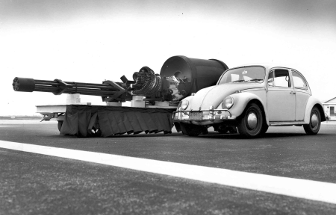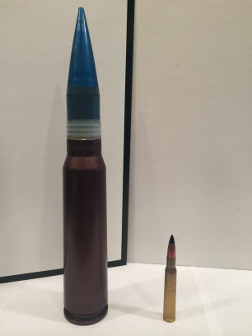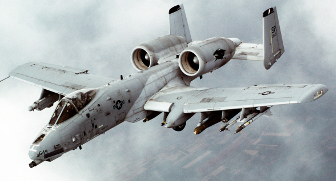
Public domain photo by the U.S. Air Force.
by John Walker

When admiring somebody’s tricked-out AK or AR platform, complete with Picatinny rail, laser, night vision sight, suppressor, and bayonet, you might be inclined to say, “What a badass weapon!”
But when it comes to badassery among firearms, there is a pyramid, and near the peak is the GAU-8 Avenger. Let’s look at some of the details of this bad boy.
Well, first of all, it’s big—cast your eye at the picture above comparing it to a Volkswagen beetle. What you see is the gun itself, at the left, which is 2.85 metres long, attached to the ammunition feed assembly (together, they are called the A/A 49E-6 Gun System), which brings the total length to 6 metres. The barrels are 2.3 metres in length, chambered for the 30×173 mm cannon round. Total weight, without ammunition, is 281 kg; fully loaded the gun and ammunition weigh around 1800 kg. This is not your weapon of choice for concealed carry.
The design is based upon that of the 19th century Gatling gun. There are seven barrels mounted around the periphery of a cylinder. While the original Gatling gun was hand cranked, the GAU-8’s barrel cylinder is rotated by two hydraulic motors. Although it is a repeating weapon, it is not an automatic weapon in the usual sense. As the cylinder rotates, each barrel is loaded, fired, unloaded, and reloaded in sequence by a system of cams. The recoil and gas from rounds fired plays no part in the operation of the gun. (This means that a misfire does not affect the firing of subsequent rounds.)

The gun is chambered for the 30×173 mm round. There are three versions of this round: an armour piercing incendiary with a projectile consisting of an aluminium jacket and a depleted uranium penetrator, and a high explosive incendiary. A combat load usually consists of a belt with five of the armour piercing rounds to one high explosive. An inexpensive target practice round is also available. If you’re in the market, here is the data sheet. The ammunition uses a lightweight aluminium cartridge case instead of the usual brass or steel. This allows aircraft to carry more rounds.
Ballistic performance of the three kinds of ammunition is almost identical. The muzzle velocity of the armour piercing incendiary round (PGU-14 API) is 1013 metres/second, with a projectile mass of 395 grams. This gives a muzzle energy of around 203,000 joules. This is on the order of ten times the energy of the .50 BMG round, which is generally considered rather badass, and more than a hundred times that of the 5.56×45 mm cartridge fired by the M-16 and its variants. If one of these is coming your way, hiding behind a car won’t save you. Neither will hiding behind a tank.
But the whole point of the GAU-8 is that there’s never just one round coming your way. As each barrel rotates to the 9 o’clock position as seen from the front (Pro Tip: don’t observe it from there), it fires, and rounds are discharged as rapidly as the barrel cylinder spins. When the trigger is initially pulled and the barrel spins up, it fires about 50 rounds in the first second, then 65 rounds per second thereafter. The sustained rate of fire is 3900 rounds per minute, or 65 rounds per second. It does not sound like a machine gun: the rate of fire is so rapid it’s more like brrrrrrrp!
The gun is usually fired in one or two second bursts, but there’s no reason the entire ammunition load of 1150 rounds couldn’t be expended in a single mad 18 second burst. Anybody who did this would probably have some ’splainin’ to do and lots of forms to fill out, as it would reduce barrel life.
Accuracy is specified as 80% of rounds falling within a cone five milliradians from the point of aim. At a range of 1200 metres, 80% of rounds will hit within a 12 metre diameter circle.

The GAU-8 is carried by the A-10 Thunderbolt II close air support aircraft, better known by its nickname, “Warthog”. Well, not so much carried: it’s more accurate to say that the A-10 was built around the gun. The gun accounts of 16% of the plane’s weight; when it’s removed, the plane has to be mounted on a jack stand to keep it from tipping back on its tail. The gun is installed offset to the right as viewed from the front (again, don’t stand there) so that the firing barrel will be aligned with the centre line of the plane as it fires. This is important: the recoil from a GAU-8 firing full-tilt is greater than the thrust of one the plane’s two engines, and if it were offset from the centre of mass, firing the gun would cause the plane to veer off course. When the gun fires, the oxygen-free combustion products from the ammunition may be ingested into the plane’s engines, causing them to flame out. The engine igniters are automatically activated whenever the gun is firing to prevent this. Spent cartridge cases are not ejected overboard; this would shift the centre of gravity of the plane and possibly render it uncontrollable, as well as pose a hazard to any plane flying nearby or below. Instead, they are captured and retained in the ammunition magazine, then unloaded at the end of the mission.
The A-10 is the only aircraft to use the GAU-8. It was designed into the Dutch Goalkeeper CIWS (Close-In Weapon System) shipboard defense system, which is deployed by the navies of eight countries. Naturally, one wonders about other applications. Randall Munroe has calculated that if you mounted a GAU-8 on a compact car, pointed aft, and fired it, you could accelerate to the speed limit in less than three seconds. There is a delightful cartoon, which I can’t reproduce here for reasons of copyright, in the article discussing this. This may not be such a great idea, but it’s cool; where are the Mythbusters when you need them?
Here is a short film about the A-10 and GAU-8.
Tests of the GAU-8 on the test stand and airborne:
This document is in the public domain.